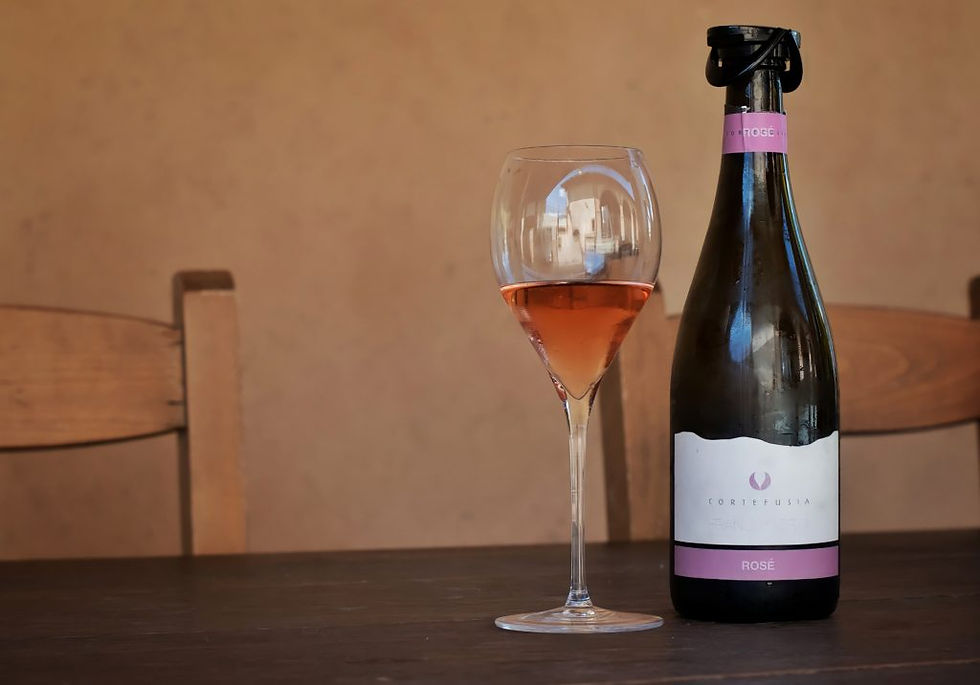Franciacorta is an area on the edge of the Alps, just south of Lake Iseo, and here there is a 60-year-old tradition of making spumante or foaming wines. In Italy they differentiate between frizzante wine, which has an internal pressure of less than 2.5 bar - meaning it sparkles - and the full spumante that requires in excess of 3.0 bar and frequently is in excess of 6.0 bar.
“How do they do that? '' asked Vinnie, my corkscrew, who was, unusually, paying close attention. Well, the explanation is a little technical but, in the metodo tradizionale, after the initial fermentation that is done in the conventional manner the wine is bottled but with a space left for the addition of what is termed the liqueur de tirage. This is a mixture of wine sugar and yeast that is added to the bottle that is then sealed. Today, this is normally done with a crown cap. The fermentation that follows produces carbon dioxide that then dissolves under pressure into the wine to produce the sought-after bubbles.

After that rather lengthy explanation, we arrived at our destination, Corte Fusia, in the small town of Coccaglio on the southern slopes of Monte Orfano or the orphan mountain. It is so called because it rises in isolation from the foothills of the Alps to the north and marks the southern edge of the region that can put the name Franciacorta to its wines. This is a relatively new winery, founded in 2010 by two friends, Daniele and Gigi, and from a modest 7 hectares of vines they produce around 30,000 bottles of wine per year.

The majority of Franciacorta wines come from wines grown on glacial moraine but the terroir of Monte Orfano is very different as it was originally part of the sea bed. The four vineyards of Corte Fusia are spread over seven hectares and have five distinct soil types within them. It also has a different climate. The majority of the region has cool winds coming down from Lake Iseo and the Alpine heights but here, on the south side of the mountain, there is a more Mediterranean climate. In addition, the terrain is not easy to cultivate; the steep hillsides mean that yields at three tonnes per hectare are around half that of the vineyards further north. The winery itself is situated in an old family property with wonderful vaulted brick ceilings dating back to the 16th century. Inside the property there are the clean lines of modern stainless steel vats from which they produce four wines.

One of these is called Satèn, which is the generic name for a wine produced specifically in Franciacorta. The rules governing this wine state that it must be a least 50% Chardonnay and allow for the use of up to 50% Pinot Bianco but perhaps the most interesting part of the regulations is that the maximum pressure permitted in the bottle is 5.0 bar which contrasts with the more usual 6.0 bar plus for spumante wines of this area. This lower pressure is achieved by using reduced sugar in the liqueur de tirage. The result is smaller, creamier bubbles making for a smoother feel to the wine. The version that Daniele and Gigi make is 90% Chardonnay and spends 3 years on the lees compared with the specified minimum of 24 months. The result has a pale yellow colour with a bouquet of brioche and on the palate there is lemon with the butteriness of Chardonnay and a hint of salinity at the back of the tongue.

The friends also make a Brut that is 70% Chardonnay, 20% Pinot Nero, and 10% Pinot Bianco. This spends two years on the lees in the bottle, nurturing the carbon dioxide that will eventually be unleashed in a vibrant, bubbling mousse to the universal applause that always greets this event, wherever and whenever it occurs. The colour is a delicate pale yellow with brioche and floral notes on the nose with flavours of almond and lemon in the mouth.

Finally, I sampled their 2016 Rosé that is 100% Pinot Nero. The grapes come from two vineyards that are fermented separately before being blended and bottled. I sampled both and the difference was marked. The wine from the higher vineyard was full of the flavour of grapefruit whilst that from the lower tasted of raspberries. Blended, bottled, and allowed to mature for two years the result is, quite naturally, a little different. The fruity bouquet is redolent of blackberries with the dry tang of pomegranates on the palate with a pleasant salinity. This would be great as an aperitif.
These two young men, one an agronomist and the other an oenologist, have come together to realise their shared desire to produce wines that truly represent the best that this very individual territory with its particular microclimate has to offer and I am pleased to report that, for me, they have succeeded.
Useful links:

Komentarze